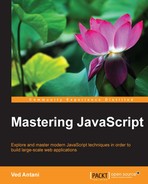We introduced you to anonymous functions a bit earlier in this chapter, and as they're a crucial concept, we will take a detailed look at them. For a language inspired by Scheme, anonymous functions are an important logical and structural construct.
Anonymous functions are typically used in cases where the function doesn't need to have a name for later reference. Let's look at some of the most popular usages of anonymous functions.
An anonymous function can be assigned to an object property. When we do that, we can call that function with a dot (.) operator. If you are coming from a Java or other OO language background, you will find this very familiar. In such languages, a function, which is part of a class is generally called with a notation—Class.function(). Let's consider the following example:
var santa = {
say :function(){
console.log("ho ho ho");
}
}
santa.say();In this example, we are creating an object with a say property, which is an anonymous function. In this particular case, this property is known as a method and not a function. We don't need to name this function because we are going to invoke it as the object property. This is a popular pattern and should come in handy.
Here, we are creating two anonymous functions and adding them to an array. (We will take a detailed look at arrays later.) Then, you loop through this array and execute the functions in a loop:
<script type="text/javascript">
var things = [
function() { alert("ThingOne") },
function() { alert("ThingTwo") },
];
for(var x=0; x<things.length; x++) {
things[x]();
}
</script>This is one of the most popular patterns and you will find such code in most professional libraries:
// function statement
function eventHandler(event){
event();
}
eventHandler(function(){
//do a lot of event related things
console.log("Event fired");
});You are passing the anonymous function to another function. In the receiving function, you are executing the function passed as a parameter. This can be very convenient if you are creating single-use functions such as object methods or event handlers. The anonymous function syntax is more concise than declaring a function and then doing something with it as two separate steps.
You can use anonymous function expressions to conditionally change behavior. The following example shows this pattern:
var shape;
if(shape_name === "SQUARE") {
shape = function() {
return "drawing square";
}
}
else {
shape = function() {
return "drawing square";
}
}
alert(shape());Here, based on a condition, we are assigning a different implementation to the shape variable. This pattern can be very useful if used with care. Overusing this can result in unreadable and difficult-to-debug code.
Later in this book, we will look at several functional tricks such as memoization and caching function calls. If you have reached here by quickly reading through the entire chapter, I would suggest that you stop for a while and contemplate on what we have discussed so far. The last few pages contain a ton of information and it will take some time for all this information to sink in. I would suggest that you reread this chapter before proceeding further. The next section will focus on closures and the module pattern.
